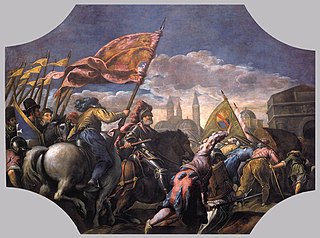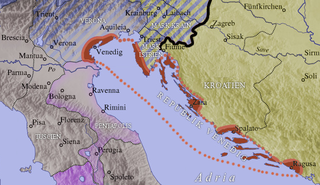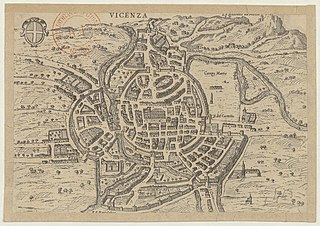
The House of Este is a European dynasty of North Italian origin whose members ruled parts of Italy and Germany for many centuries.

The Duchy of Milan was a state in Northern Italy, created in 1395 by Gian Galeazzo Visconti, then the lord of Milan, and a member of the important Visconti family, which had been ruling the city since 1277.

The War of the League of Cambrai, sometimes known as the War of the Holy League and several other names, was fought from February 1508 to December 1516 as part of the Italian Wars of 1494–1559. The main participants of the war, who fought for its entire duration, were France, the Papal States, and the Republic of Venice; they were joined at various times by nearly every significant power in Western Europe, including Spain, the Holy Roman Empire, England, the Duchy of Milan, the Republic of Florence, the Duchy of Ferrara, and the Swiss.

Lonato del Garda is a town and comune in the province of Brescia, in Lombardy, northern Italy. Lonato is located about halfway between Milan and Venice, on the southwest shore of Lake Garda, the biggest lake in Italy.

Leonardo Loredan was a Venetian nobleman and statesman who reigned as the 75th Doge of Venice from 1501 until his death in 1521. As a wartime ruler, he was one of the most important doges in the history of Venice. In the dramatic events of the early 16th century, Loredan's Machiavellian plots and cunning political manoeuvres against the League of Cambrai, the Ottomans, the Mamluks, the Pope, the Republic of Genoa, the Holy Roman Empire, the French, the Egyptians and the Portuguese saved Venice from downfall.

Andrea Gritti was the Doge of the Venetian Republic from 1523 to 1538, following a distinguished diplomatic and military career. He started out as a successful merchant in Constantinople and transitioned into the position of Bailo, a diplomatic role. He was arrested for espionage but was spared execution thanks to his good relationship with the Ottoman vizier. After being freed from imprisonment, he returned to Venice and began his political career. When the War of the League of Cambrai broke out, despite his lack of experience, he was given a leadership role in the Venetian military, where he excelled. After the war, he was elected doge, and he held that post until his death.

Niccolò di Pitigliano (1442–1510) was an Italian condottiero best known as the Captain-General of the Venetians during the Most Serene Republic's war against the League of Cambrai. He was a member of the powerful feudal family of the Orsini, belonging to its Pitigliano line.

The siege of Padua was a major engagement early in the War of the League of Cambrai.

The Wars in Lombardy were a series of conflicts between the Republic of Venice and the Duchy of Milan and their respective allies, fought in four campaigns in a struggle for hegemony in Northern Italy that ravaged the economy of Lombardy. They lasted from 1423 until the signing of the Treaty of Lodi in 1454. During their course, the political structure of Italy was transformed: out of a competitive congeries of communes and city-states emerged the five major Italian territorial powers that would make up the map of Italy for the remainder of the 15th century and the beginning of the Italian Wars at the turn of the 16th century. They were Venice, Milan, Florence, the Papal States and Naples. Important cultural centers of Tuscany and Northern Italy—Siena, Pisa, Urbino, Mantua, Ferrara—became politically marginalized.

Medole is a comune (municipality) is an Italian municipality of 4,122 inhabitants in the province of Mantua in Lombardy.

The Republic of Venice was a sovereign state and maritime republic in Northeast Italy, which existed for a millennium between the 8th century and 1797.
This article presents a detailed timeline of the history of the Republic of Venice from its legendary foundation to its collapse under the efforts of Napoleon.

The Battle of La Motta, also known as the Battle of Schio, Battle of Vicenza or Battle of Creazzo, took place at Schio, in the Italian region of Veneto, Republic of Venice, on 7 October 1513, between the forces of the Republic of Venice and a combined force of Spain and the Holy Roman Empire, and was a significant battle of the War of the League of Cambrai. A Venetian army under Bartolomeo d'Alviano was decisively defeated by the Spanish/Imperial army commanded by Ramón de Cardona and Fernando d'Ávalos.

Francesco Gonzaga was an Italian bishop and a Cardinal of the Roman Catholic Church during the reigns of Popes Pius II, Paul II and Sixtus IV.

The siege of Mirandola occurred in January 1511 as a part of Pope Julius II's campaign to keep France from dominating northern Italy during the War of the League of Cambrai. At that time Mirandola was the capital of the Duchy of Mirandola in the Italian region of Emilia. The siege was conducted by Julius after he had broken away from the League of Cambrai and entered into a treaty with Venice.

The Republic of Venice was dissolved and dismembered by the French general Napoleon Bonaparte and the Habsburg Monarchy on 12 May 1797.

Girolamo Donato, also spelled Donati, Donado or Donà, was a Venetian diplomat and humanist. He made important translations of ancient Greek philosophy and the Greek Fathers into Latin. He served the Republic of Venice on embassies abroad on twelve separate occasions, most importantly at Rome four times, and also served as a governor of Ravenna (1492), Brescia (1495–97), Cremona (1503–04) and Crete (1506–08).
Giovanni Badoer or Zuan Badoer was a poet, politician and diplomat of the Republic of Venice.

The Battle of the citadel of Vicenza was fought between November 26 and 29, 1509 in Vicenza, Italy as an episode of the War of the League of Cambrai.

















